Elastomer with Microchannel Nanofiber Array Inspired by Rabbit Cornea Achieves Rapid Liquid Spreading and Reduction of Frictional Vibration Noise
Abstract
1. Introduction
2. Materials and Methods
2.1. Materials
2.2. Principle of Biological Super Spreading and Preparation Process of Biomimetic Samples
2.3. Experimental Setup
2.4. Characterization Method
3. Results and Discussion
3.1. Surface Morphology and Wettability Characterization
3.2. Friction Vibration Noise and Wear Testing
4. Conclusions
Supplementary Materials
Author Contributions
Funding
Institutional Review Board Statement
Data Availability Statement
Conflicts of Interest
References
- Lontin, K.; Khan, M. Interdependence of friction, wear, and noise: A review. Friction 2021, 9, 1319–1345. [Google Scholar] [CrossRef]
- Akay, A. Acoustics of friction. J. Acoust. Soc. Am. 2002, 111, 1525–1548. [Google Scholar] [CrossRef] [PubMed]
- Dong, C.; Mo, J.; Yuan, C.; Bai, X.; Tian, Y. Vibration and Noise Behaviors During Stick–Slip Friction. Tribol. Lett. 2019, 67, 1–12. [Google Scholar] [CrossRef]
- Kim, C.S.; Grady, S.T.; Hart, J.E.; Laden, F.; VoPham, T.; Nguyen, D.D.; Manson, J.E.; James, P.; Forman, J.P.; Rexrode, K.M.; et al. Long-term aircraft noise exposure and risk of hypertension in the Nurses’ Health Studies. Environ. Res. 2022, 207, 112195. [Google Scholar] [CrossRef] [PubMed]
- Way, J.T.; Long, A.; Weihing, J.; Ritchie, R.; Jones, R.; Bush, M.; Shinn, J.B. Effect of Noise on Auditory Processing in the Operating Room. J. Am. Coll. Surg. 2013, 216, 933–938. [Google Scholar] [CrossRef] [PubMed]
- Le Rouzic, J.; Le Bot, A.; Perret-Liaudet, J.; Guibert, M.; Rusanov, A.; Douminge, L.; Bretagnol, F.; Mazuyer, D. Friction-Induced Vibration by Stribeck’s Law: Application to Wiper Blade Squeal Noise. Tribol. Lett. 2013, 49, 563–572. [Google Scholar] [CrossRef]
- Avramov, K. Chaotic frictional vibrations excited by a quasiperiodic load. Int. Appl. Mech. 2006, 42, 1071–1076. [Google Scholar] [CrossRef]
- Ouyang, H.; Mottershead, J.E.; Cartmell, M.P.; Friswell, M.I. Friction-Induced Parametric Resonances in Discs: Effect of a Negative Friction–Velocity Relationship. J. Sound Vib. 1998, 209, 251–264. [Google Scholar] [CrossRef]
- Wang, X.C.; Mo, J.L.; Ouyang, H.; Huang, B.; Lu, X.D.; Zhou, Z.R. An investigation of stick-slip oscillation of Mn–Cu damping alloy as a friction material. Tribol. Int. 2020, 146, 67–103. [Google Scholar] [CrossRef]
- Wang, A.Y.; Mo, J.L.; Wang, X.C.; Zhu, M.H.; Zhou, Z.R. Effect of surface roughness on friction-induced noise: Exploring the generation of squeal at sliding friction interface. Wear 2018, 402–403, 80–90. [Google Scholar] [CrossRef]
- Wang, D.W.; Mo, J.L.; Liu, M.Q.; Ouyang, H.; Zhou, Z.R. Noise performance improvements and tribological consequences of a pad-on-disc system through groove-textured disc surface. Tribol. Int. 2016, 102, 222–236. [Google Scholar] [CrossRef]
- Mo, J.L.; Wang, Z.G.; Chen, G.X.; Shao, T.M.; Zhu, M.H.; Zhou, Z.R. The effect of groove-textured surface on friction and wear and friction-induced vibration and noise. Wear 2013, 301, 671–681. [Google Scholar] [CrossRef]
- Galda, L.; Pawlus, P.; Sep, J. Dimples shape and distribution effect on characteristics of Stribeck curve. Tribol. Int. 2009, 42, 1505–1512. [Google Scholar] [CrossRef]
- Niu, C.; Liu, Y.; Shang, D.; Zhang, C. Noise Reduction Effect of Superhydrophobic Surfaces with Streamwise Strip of Channel Flow. Appl. Sci. 2021, 11, 3869. [Google Scholar] [CrossRef]
- Liu, S.; Dong, C.; Yuan, C.; Bai, X.; Tian, Y.; Zhang, G. A new polyimide matrix composite to improve friction-induced chatter performance through reducing fluctuation in friction force. Compos. Pt. B Eng. 2021, 217, 108887. [Google Scholar] [CrossRef]
- Peng, Y.; Serfass, C.M.; Kawazoe, A.; Shao, Y.; Gutierrez, K.; Hill, C.N.; Santos, V.J.; Visell, Y.; Hsiao, L.C. Elastohydrodynamic friction of robotic and human fingers on soft micropatterned substrates. Nat. Mater. 2021, 20, 1707–1711. [Google Scholar] [CrossRef]
- Dong, C.; Shi, L.; Li, L.; Bai, X.; Yuan, C.; Tian, Y. Stick-slip behaviours of water lubrication polymer materials under low speed conditions. Tribol. Int. 2017, 106, 55–61. [Google Scholar] [CrossRef]
- Feng, L.; Li, S.; Li, Y.; Li, H.; Zhang, L.; Zhai, J.; Song, Y.; Liu, B.; Jiang, L.; Zhu, D. Super-hydrophobic surfaces: From natural to artificial. Adv. Mater. 2002, 14, 1857–1860. [Google Scholar] [CrossRef]
- Davenport, J.; Hughes, R.N.; Shorten, M.; Larsen, P.S. Drag reduction by air release promotes fast ascent in jumping emperor penguins—A novel hypothesis. Mar. Ecol.-Prog. Ser. 2011, 430, 171–182. [Google Scholar] [CrossRef]
- Ou, J.; Perot, B.; Rothstein, J.P. Laminar drag reduction in microchannels using ultrahydrophobic surfaces. Phys. Fluids 2004, 16, 4635–4643. [Google Scholar] [CrossRef]
- Hassanalian, M.; Abdelmoula, H.; Mohammadi, S.; Bakhtiyarov, S.; Goerlich, J.; Javed, U. Aquatic animal colors and skin temperature: Biology’s selection for reducing oceanic dolphin’s skin friction drag. J. Therm. Biol. 2019, 84, 292–310. [Google Scholar] [CrossRef]
- Chen, H.; Zhang, P.; Zhang, L.; Liu, H.; Jiang, Y.; Zhang, D.; Han, Z.; Jiang, L. Continuous directional water transport on the peristome surface of Nepenthes alata. Nature 2016, 532, 85–89. [Google Scholar] [CrossRef]
- Miao, W.; Zheng, S.; Zhou, J.; Zhang, B.; Fang, R.; Hao, D.; Sun, L.; Wang, D.; Zhu, Z.; Jin, X. Microchannel and nanofiber array morphology enhanced rapid superspreading on animals’ corneas. Adv. Mater. 2021, 33, 2007152. [Google Scholar] [CrossRef] [PubMed]
- Linh, V.T.N.; Han, S.; Koh, E.; Kim, S.; Jung, H.S.; Koo, J. Advances in wearable electronics for monitoring human organs: Bridging external and internal health assessments. Biomaterials 2024, 314, 122865. [Google Scholar] [CrossRef]
- Li, N.; Dong, C.; Wu, Y. Reinforcement of frictional vibration noise reduction properties of a polymer material by PTFE particles. Materials 2022, 15, 1365. [Google Scholar] [CrossRef] [PubMed]
- Qin, S.; Shi, X.; Xue, Y.; Huang, Q.; Zhang, K. Tribological behaviors and friction-induced vibration and noise performance of TC4 with bionic coating prepared by laser additive manufacturing. J. Mater. Eng. Perform. 2021, 30, 9455–9469. [Google Scholar] [CrossRef]
- Chen, Y.; Shi, X.; Lu, G.; Zhou, H.; Yang, Z. Reducing friction noise of M50 matrix composites by adding Ti3SiC2. Mater Res. Express 2019, 6, 6–7. [Google Scholar] [CrossRef]
- Wang, D.W.; Mo, J.L.; Zhu, Z.Y.; Ouyang, H.; Zhu, M.H.; Zhou, Z.R. How do grooves on friction interface affect tribological and vibration and squeal noise performance. Tribol. Int. 2017, 109, 192–205. [Google Scholar] [CrossRef]
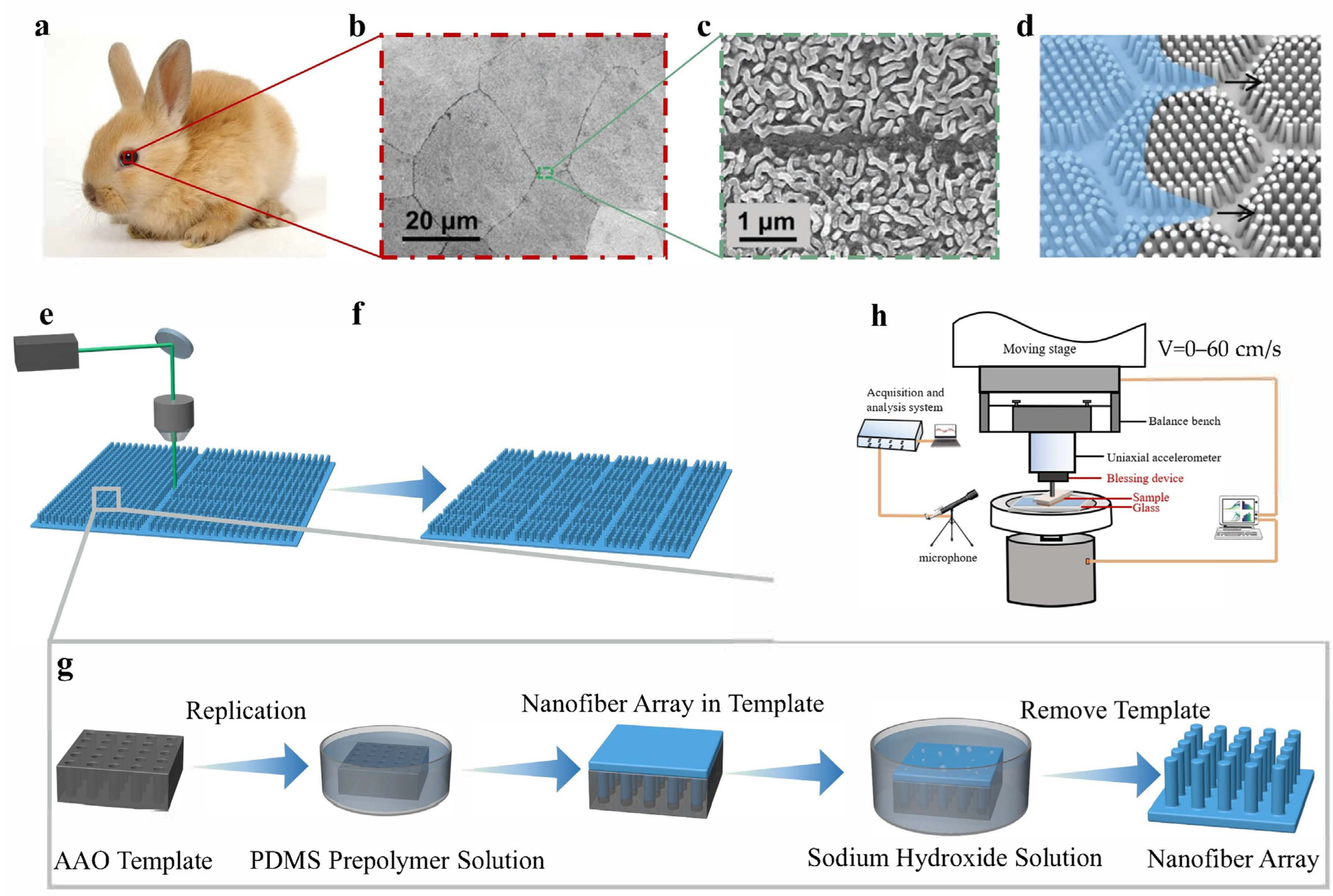
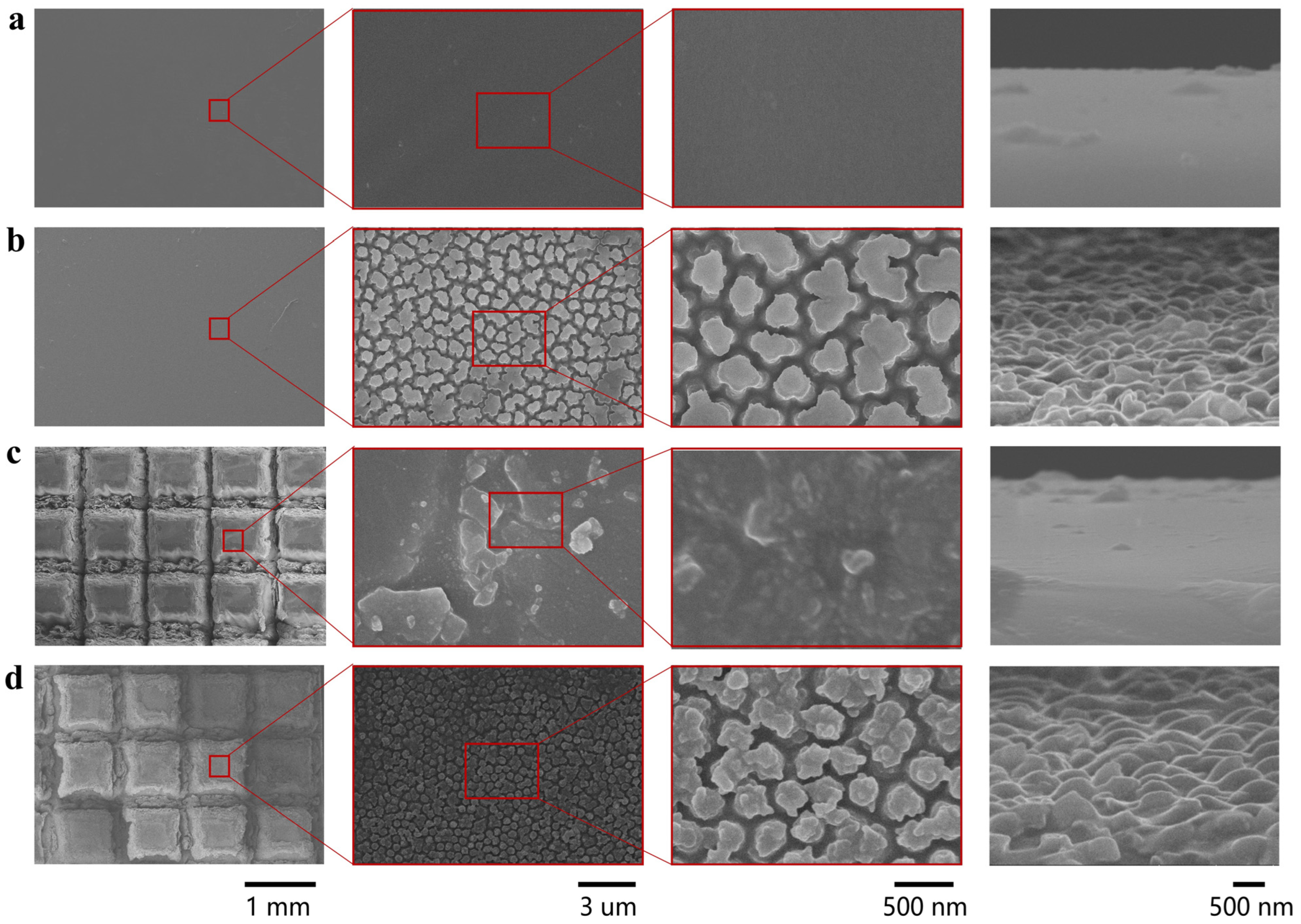
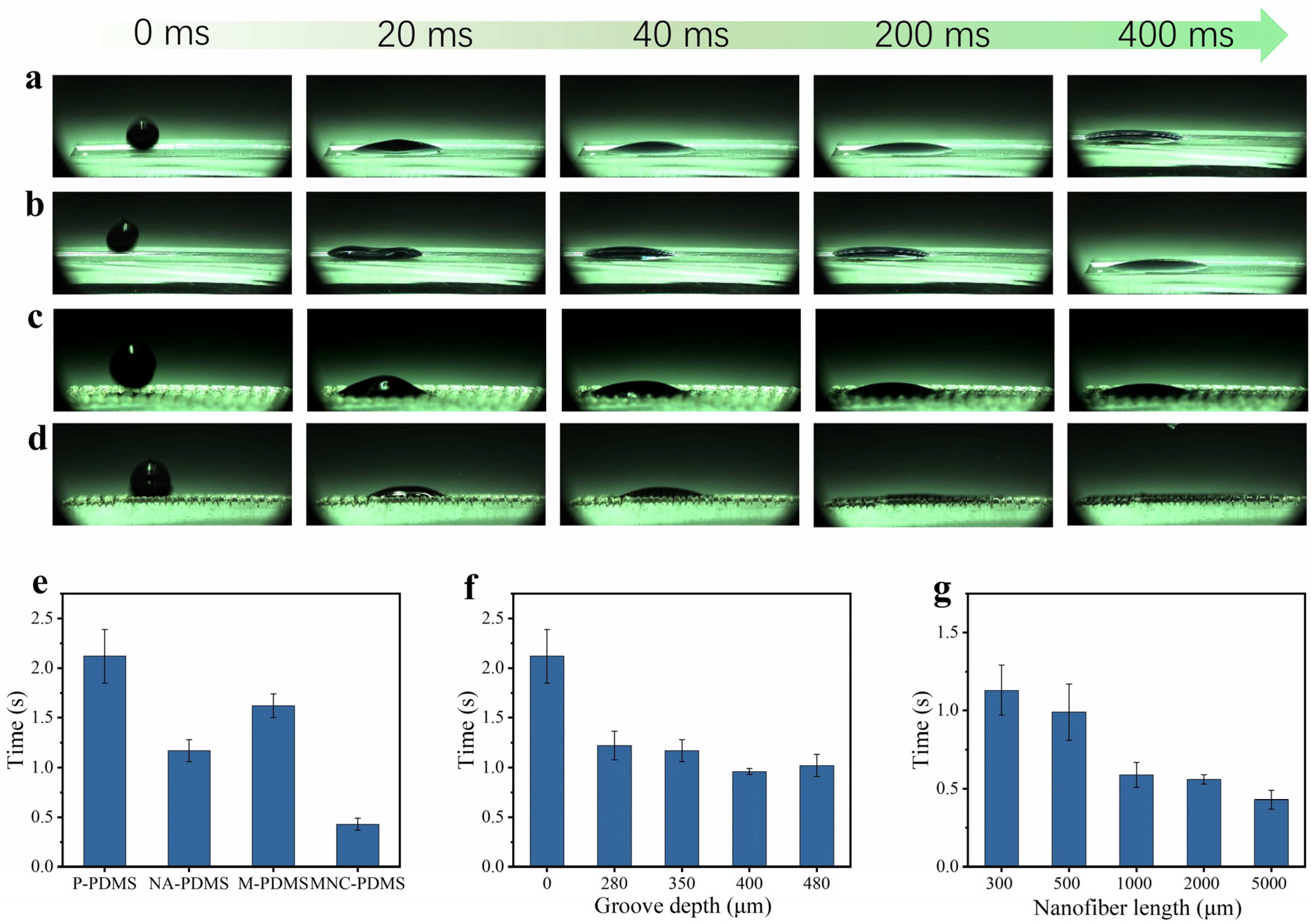
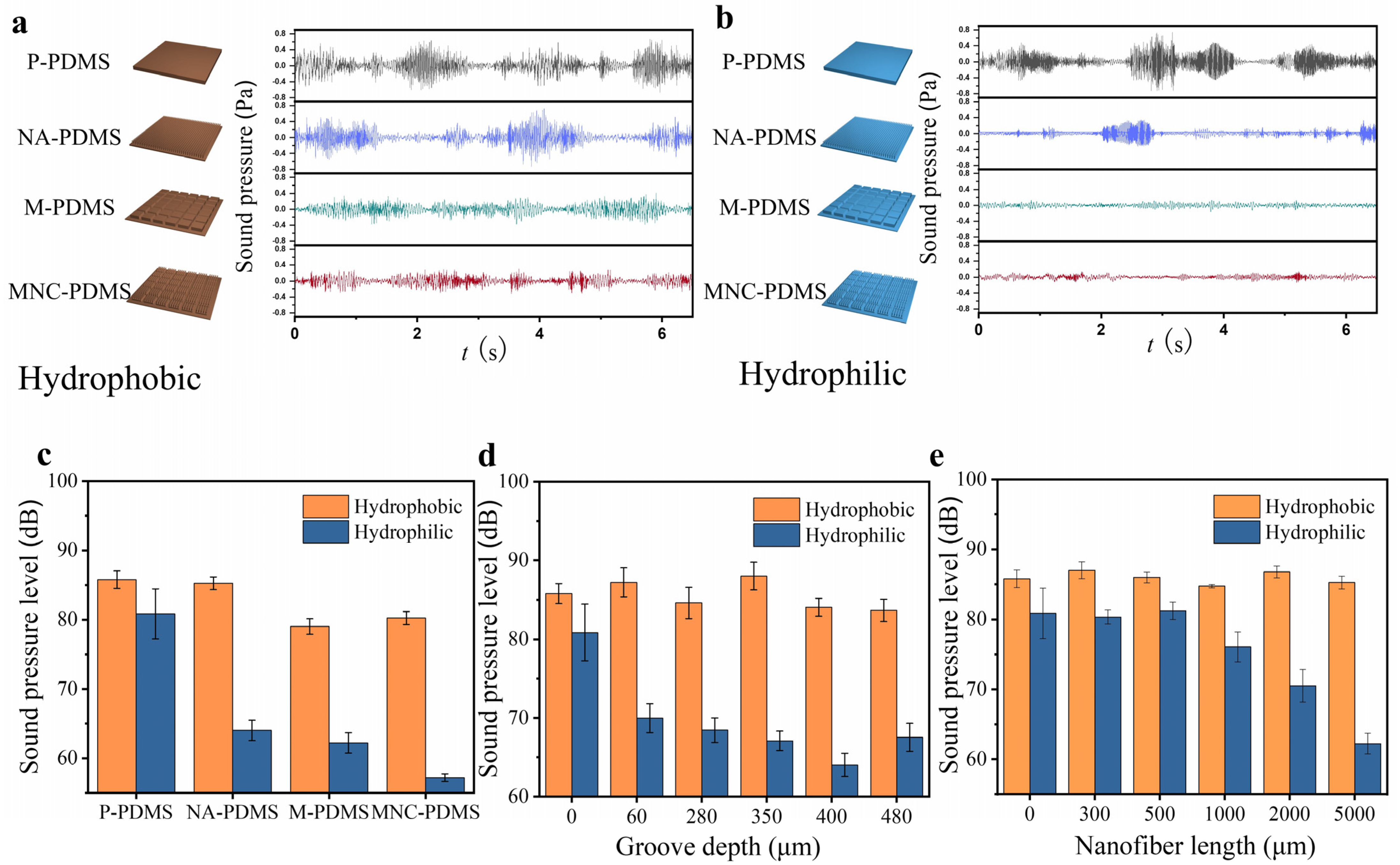
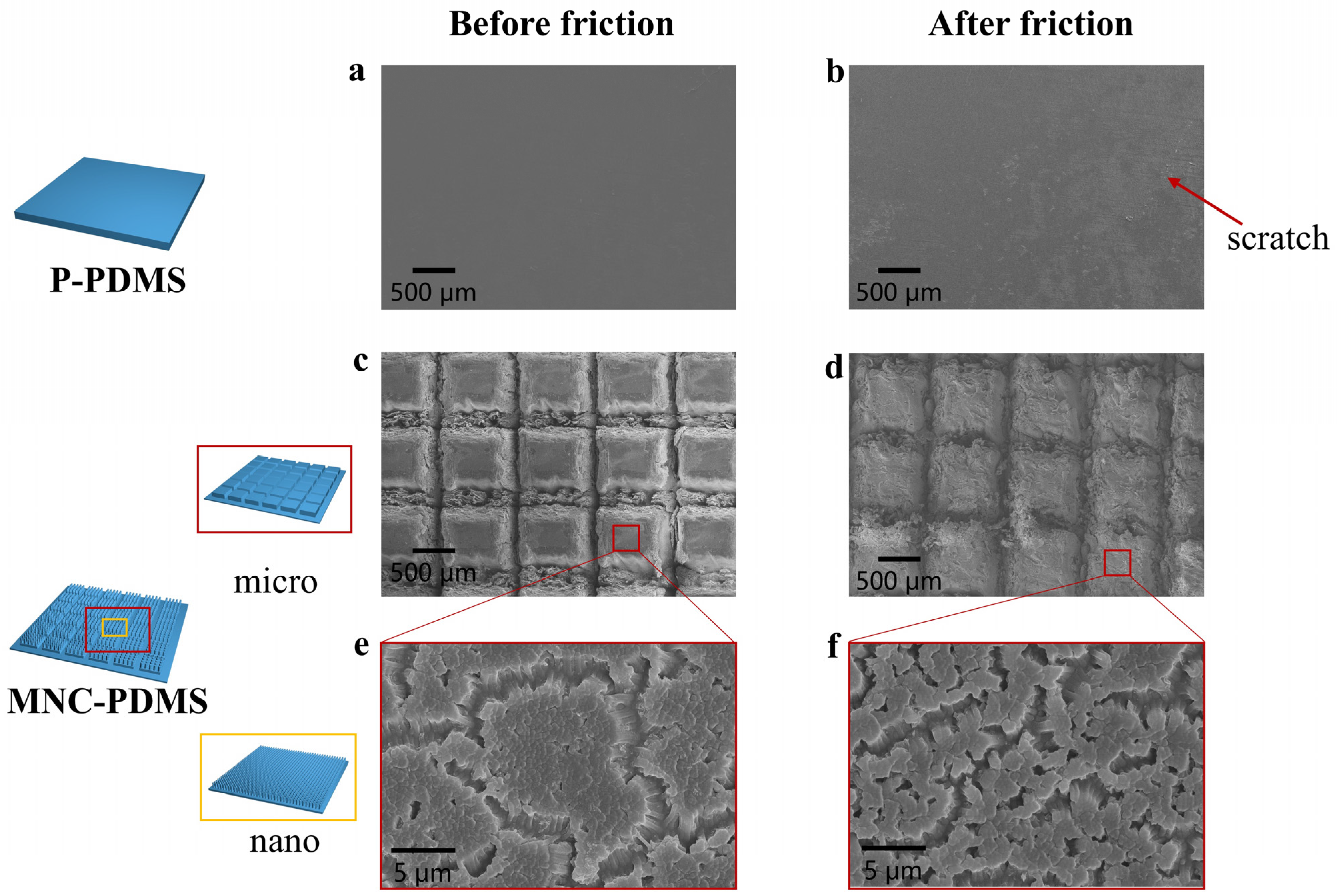
Disclaimer/Publisher’s Note: The statements, opinions and data contained in all publications are solely those of the individual author(s) and contributor(s) and not of MDPI and/or the editor(s). MDPI and/or the editor(s) disclaim responsibility for any injury to people or property resulting from any ideas, methods, instructions or products referred to in the content. |
© 2025 by the authors. Licensee MDPI, Basel, Switzerland. This article is an open access article distributed under the terms and conditions of the Creative Commons Attribution (CC BY) license (https://creativecommons.org/licenses/by/4.0/).
Share and Cite
Zhang, B.; Jiang, L.; Fang, R. Elastomer with Microchannel Nanofiber Array Inspired by Rabbit Cornea Achieves Rapid Liquid Spreading and Reduction of Frictional Vibration Noise. Biomimetics 2025, 10, 164. https://doi.org/10.3390/biomimetics10030164
Zhang B, Jiang L, Fang R. Elastomer with Microchannel Nanofiber Array Inspired by Rabbit Cornea Achieves Rapid Liquid Spreading and Reduction of Frictional Vibration Noise. Biomimetics. 2025; 10(3):164. https://doi.org/10.3390/biomimetics10030164
Chicago/Turabian StyleZhang, Bowen, Lei Jiang, and Ruochen Fang. 2025. "Elastomer with Microchannel Nanofiber Array Inspired by Rabbit Cornea Achieves Rapid Liquid Spreading and Reduction of Frictional Vibration Noise" Biomimetics 10, no. 3: 164. https://doi.org/10.3390/biomimetics10030164
APA StyleZhang, B., Jiang, L., & Fang, R. (2025). Elastomer with Microchannel Nanofiber Array Inspired by Rabbit Cornea Achieves Rapid Liquid Spreading and Reduction of Frictional Vibration Noise. Biomimetics, 10(3), 164. https://doi.org/10.3390/biomimetics10030164





